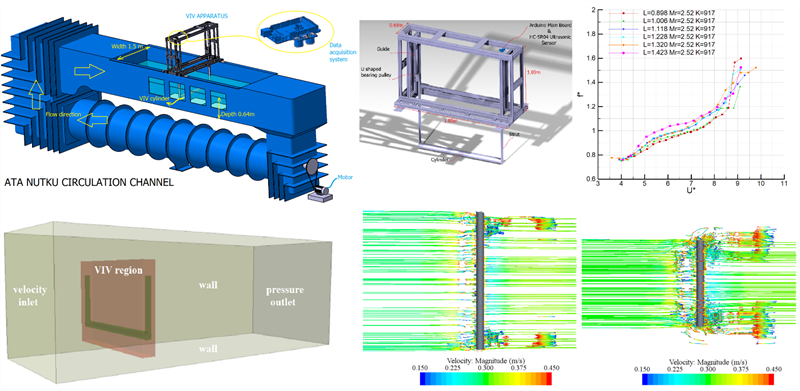Vortex induced vibrations (VIV) are motions induced on bluff bodies which get excited by an external fluid flow. This fluid-structure interactions, have been extensively investigated during the recent years by virtue of its considerable effects on various engineering structures such as bridges, skyscrapers, towers, power transmission lines and offshore structures. VIV is generally known as a negative phenomenon on engineering structures however, recent studies have shown that it is possible to develop engineering mechanisms by taking advantage of VIV and put it into beneficial uses. VIV can generate renewable energy with a proper apparatus placed in a stream, or pump water from rivers without any running cost.
In this study; experimental and numerical investigations into tip effects on vortex induced vibrations (VIV) for circular cylinders are performed, supervised by our faculty member Dr. Omer Kemal Kinaci. VIV experiments have been carried out on the circulation channel located in the Ata Nutku Ship Model Testing Laboratory at ITU. The channel streams a uniform steady current over a range of 0<U<1.56 m/s towards the VIV apparatus while the apparatus is stationary.
The VIV tests are carried out for six different smooth circular cylinders with different aspect ratios at TrSL2 and TrSL3 flow regimes having one degree-of-freedom. In the tests, the values of mass ratio, the aspect ratio and the spring stiffness are changed systematically and the tip effects on these parameters were investigated with respect to the VIV responses of the cylinders. An uncertainty analysis is also carried out to obtain the margin of bias and precision errors on the test results of oscillation amplitude for the shortest and longest cylinders in initial, upper and lower branches. After the VIV tests validated and verified, the flow around the shortest and longest cylinders are visualized with CFD to understand the physical insight. Experimental data of amplitudes and frequencies are defined as the inputs of numerical simulations with forced oscillation.

The experiments have shown that;
* The lower branch disappears in TrSL3 flow regime as reported in the literature.
* The upper branch initiates earlier leading to a wider range of synchronization in cylinders having higher aspect ratios.
* Tip flows are dominant in lower mass ratio cylinders.
The CFD study have revealed that;
* Flow escape through the tips are easier in shorter cylinders, generating higher cross-flow velocities.
* Cylinder amplitudes are lower when cross-flows velocities are higher.